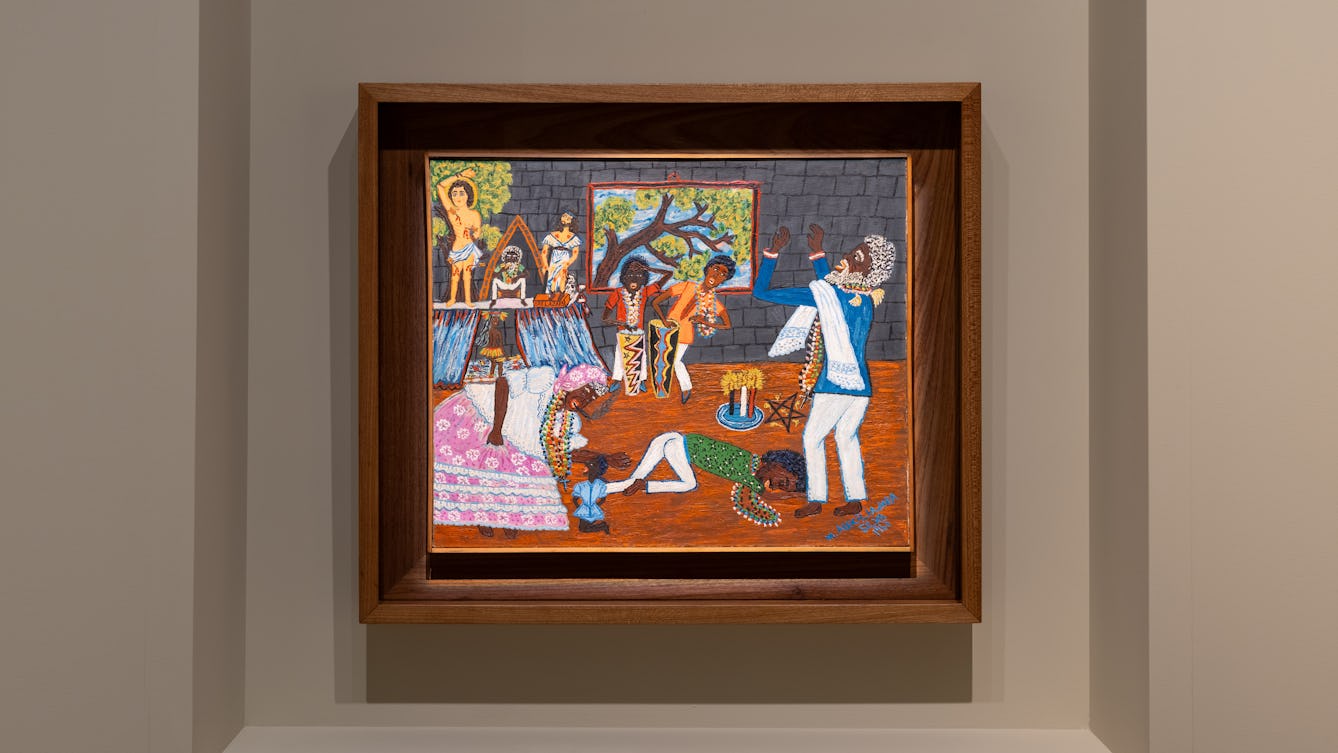Hi, it’s Cindy Sissokho again, the curator of ‘Hard Graft’.
This vibrant oil painting, measuring 50 cm high by 60 wide and displayed in an oak wood frame, captures a moment of celebratory ritual from Umbanda, an Afro-Brazilian religion. Umbanda blends African, Indigenous and European religions. It has some similarities with Candomblé, an earlier religion developed by enslaved West Africans on plantations in Brazil.
This painting, by Maria Auxiliadora da Silva, teems with joy and movement. Her practice aimed to document the daily lives of Afro-Brazilian people. She painted this work in 1968, but the scene recalls the use of spiritual healing, singing and dancing as forms of resistance and survival invented by enslaved Africans centuries before.
The ritual takes place in a terreiro, a Umbandan temple. The foreground is dominated by four figures in the middle of spiritual worship, while the background includes an altar with figures of saints. The painting predominantly features Afro-Brazilians with dark brown complexions.
At the front left of the painting a woman bends forward towards a child in a blue dress kneeling on the ground to the right, who looks up at her with a toothy grin. The woman is a ialorixá, a priestess. Her beaded rosary swings over her white lace blouse and she balances a cigar between her teeth, its smoke dissipating towards the back of the room. With her right hand she clasps her purple skirt patterned with intricate flowers, which matches her headwrap. Maria Auxiliadora da Silva learned embroidery from her mother and later worked as a seamstress; the detailed stitching on the ialorixá’s clothing reflects her skill.
At the centre foreground of the painting, a young man in a green floral shirt and white trousers lies face-down on the brown floor, eyelids closed. His arms stretch out above his head and almost touch the bare feet of an elderly man who stands with his back to us at the right forefront of the painting. This man’s arms are raised in a gesture of devotion; his head is cocked back and his mouth open. White-gold curls frame his face, and contrast with his royal-blue shirt, worn over white trousers. A white lace cloth is draped over his left shoulder.
Inscribed on the floor above the young man is a black pentagram star symbolising harmony of the five elements – fire, earth, water, air, and spirit. Beside the star, three candles – black, white and red – are brightly burning.
A grey stone wall occupies the full length of the back of the painting. In the back left corner is an altar with three religious figures on top. Historically, the use of Roman Catholic saints to embody West African orixás, or deities, was a way for enslaved Africans to hide their religious practices in plain sight in their homes on the plantation, while appearing to submit to their enslavers’ religion.
Leftmost and standing tallest on the altar is Saint Sebastian, or Oxóssi, the orixá of hunting and forests, four arrows protruding from bleeding wounds on his pale yellow, semi-naked body. Next to him is an Afro-Brazilian Preto Velho, a wise spirit of enslaved Africans, who sits on a low stool. Rightmost is Saint Lazarus, or Obaluaê, the orixá of health and healing, robes parting to reveal bloody wounds. He is also pale-skinned and stands on a small red plinth bearing his name.
The altar is curtained with a vibrant blue fabric, which parts in the centre to reveal another figure beneath, the Cabocla Flexeira, known for her knowledge of plants and for protecting against negative energies. Wearing a red-, green- and gold-feathered headpiece and matching skirt, and clutching a bow and arrow in her right hand, this Indigenous spirit is standing side-on, looking back at us over her right shoulder.
At the centre back of the room, two drummers set the beat, their hands rebounding up from atabaqué drums. Both wear white trousers – one with a red shirt, the other an orange shirt – and necklaces of coloured beads swing around their necks.
On the wall behind them, a tree sways in the wind within a red frame. Giving the impression of a window to the outside, or of a framed painting of a tree inside, Auxiliadora da Silva playfully blurs the distinction between inside and outside, signalling the importance of the natural environment in Umbanda, even when it is practised in urban environments.
This is the end of stop 5.
